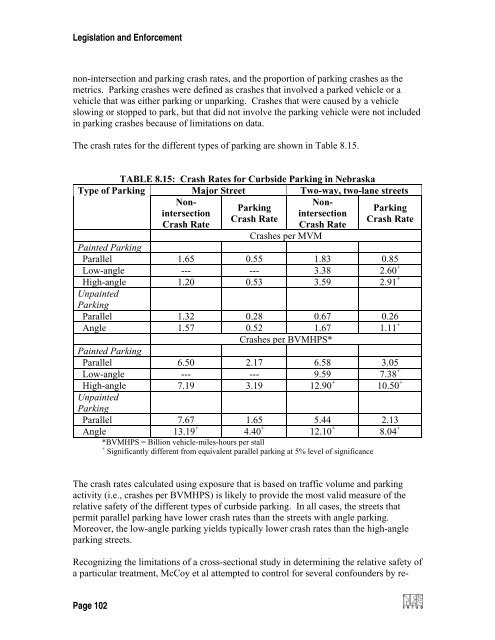Synthesis of Safety for Traffic Operations - Transports Canada
Synthesis of Safety for Traffic Operations - Transports Canada
Synthesis of Safety for Traffic Operations - Transports Canada
Create successful ePaper yourself
Turn your PDF publications into a flip-book with our unique Google optimized e-Paper software.
Legislation and En<strong>for</strong>cement<br />
non-intersection and parking crash rates, and the proportion <strong>of</strong> parking crashes as the<br />
metrics. Parking crashes were defined as crashes that involved a parked vehicle or a<br />
vehicle that was either parking or unparking. Crashes that were caused by a vehicle<br />
slowing or stopped to park, but that did not involve the parking vehicle were not included<br />
in parking crashes because <strong>of</strong> limitations on data.<br />
The crash rates <strong>for</strong> the different types <strong>of</strong> parking are shown in Table 8.15.<br />
TABLE 8.15: Crash Rates <strong>for</strong> Curbside Parking in Nebraska<br />
Type <strong>of</strong> Parking Major Street<br />
Two-way, two-lane streets<br />
Nonintersectiointersection<br />
Non-<br />
Parking<br />
Parking<br />
Crash Rate<br />
Crash Rate<br />
Crash Rate<br />
Crash Rate<br />
Crashes per MVM<br />
Painted Parking<br />
Parallel 1.65 0.55 1.83 0.85<br />
Low-angle --- --- 3.38 2.60 +<br />
High-angle 1.20 0.53 3.59 2.91 +<br />
Unpainted<br />
Parking<br />
Parallel 1.32 0.28 0.67 0.26<br />
Angle 1.57 0.52 1.67 1.11 +<br />
Crashes per BVMHPS*<br />
Painted Parking<br />
Parallel 6.50 2.17 6.58 3.05<br />
Low-angle --- --- 9.59 7.38 +<br />
High-angle 7.19 3.19 12.90 + 10.50 +<br />
Unpainted<br />
Parking<br />
Parallel 7.67 1.65 5.44 2.13<br />
Angle 13.19 + 4.40 + 12.10 + 8.04 +<br />
*BVMHPS = Billion vehicle-miles-hours per stall<br />
+ Significantly different from equivalent parallel parking at 5% level <strong>of</strong> significance<br />
The crash rates calculated using exposure that is based on traffic volume and parking<br />
activity (i.e., crashes per BVMHPS) is likely to provide the most valid measure <strong>of</strong> the<br />
relative safety <strong>of</strong> the different types <strong>of</strong> curbside parking. In all cases, the streets that<br />
permit parallel parking have lower crash rates than the streets with angle parking.<br />
Moreover, the low-angle parking yields typically lower crash rates than the high-angle<br />
parking streets.<br />
Recognizing the limitations <strong>of</strong> a cross-sectional study in determining the relative safety <strong>of</strong><br />
a particular treatment, McCoy et al attempted to control <strong>for</strong> several confounders by re-<br />
Page 102
















